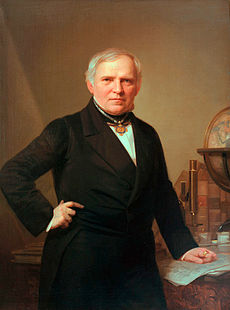- Christian Gottfried Ehrenberg
-
Christian Gottfried Ehrenberg 
Christian Gottfried EhrenbergBorn April 19, 1795
DelitzschDied June 27, 1876
BerlinNationality German Fields naturalist Notable awards Leeuwenhoek Medal (1877) Christian Gottfried Ehrenberg (April 19, 1795 – June 27, 1876), German naturalist, zoologist, comparative anatomist, geologist, and microscopist, was one of the most famous and productive scientists of his time.
Contents
Early collections
The son of a judge, Christian Gottfried Ehrenberg was born in Delitzsch, near Leipzig. He first studied theology at the University of Leipzig, then medicine and natural sciences in Berlin and became a friend of the famous explorer Alexander von Humboldt. In 1818, he completed his doctoral dissertation on fungi, Sylvae mycologicae Berolinenses.
In 1820–1825, on a scientific expedition to the Middle East with his friend Wilhelm Hemprich, he collected thousands of specimens of plants and animals. He investigated parts of Egypt, the Libyan desert, the Nile valley and the northern coasts of the Red Sea,[1] where he made a special study of the corals. Subsequently parts of Syria, Arabia and Abyssinia were examined. Some results of these travels and of the important collections that had been made were reported on by Humboldt in 1826.
After his return, Ehrenberg published several papers on insects and corals and two volumes Symbolae physicae (1828–1834), in which many particulars of the mammals, birds, insects, etc., were made public. Other observations were communicated to scientific societies.
Focus on microscopic organisms
Ehrenberg was appointed professor of medicine at Berlin University in 1827. In 1829 he accompanied Humboldt through eastern Russia to the Chinese frontier. After his return he began to concentrate his studies on microscopic organisms, which until then had not been systematically studied.
For nearly 30 years Ehrenberg examined samples of water, soil, sediment, blowing dust and rock and described thousands of new species, among them well-known flagellates such as Euglena, ciliates such as Paramecium aurelia and Paramecium caudatum, and many fossils, in nearly 400 scientific publications. He was particularly interested in a unicellular group of protists called diatoms, but he also studied, and named, many species of radiolaria and foraminifera.
These researches had an important bearing on some of the infusorial earths used for polishing and other economic purposes; they added, moreover, largely to our knowledge of the microorganisms of certain geological formations, especially of the chalk, and of the marine and freshwater accumulations. Until Ehrenberg took up the study it was not known that considerable masses of rock were composed of minute forms of animals or plants. He also demonstrated that the phosphorescence of the sea was due to organisms.
He was a member of the Royal Swedish Academy of Sciences from 1836 and a foreign member of the Royal Society of London from 1837. In 1839, he won the Wollaston Medal, the highest award granted by the Geological Society of London. He continued until late in life to investigate the microscopic organisms of the deep sea and of various geological formations. He died in Berlin on June 27, 1876.
Legacy
After his death in 1876, his collections of microscopic organisms were deposited in the Museum für Naturkunde at the University of Berlin. The "Ehrenberg Collection" includes 40,000 microscope preparations, 5,000 raw samples, 3,000 pencil and ink drawings, and nearly 1,000 letters of correspondence. His collection of scorpions, and other arachnids from the Middle East, is also held in the Berlin Museum.
He was also the first winner of the Leeuwenhoek Medal in 1877.
In his hometown, Delitzsch, the highest A-Level school, the "Ehrenberg-Gymnasium" is named after him. The best student of the school year receives the Ehrenberg Prize and a scholarship.
Publications
- The Ehrenberg Collection (including plates from Mikrogeologie, 1854) is available for download from Museum für Naturkunde, Humboldt-Universität [1]
- Die Infusionsthierchen als vollkommene Organismen (2 vols., Leipzig, 1838)
- Mikrogeologie (2 vols., Leipzig, 1854)
- "Fortsetzung der mikrogeologischen Studien", in Abhandlungen der königlichen Akademie der Wissenschaft (Berlin, 1875).
References
- ^ Bauer, A. M. (2000) 'The Symbolae Physicae and the herpetology of Hemprich and Ehrenberg’s expedition to Egypt and the Middle East" International Society for the History and Bibliography of Herpetology Newsletter and Bulletin 2(1): pp. 8–16
- ^ "Author Query". International Plant Names Index. http://www.ipni.org/ipni/authorsearchpage.do.
- Kästner, Ingrid; Wilde, Manfred (2004), "Christian Gottfried Ehrenberg (1795-1876) and the Ehrenberg collection in the museum of Schloss Delitzsch", Würzburger medizinhistorische Mitteilungen / im Auftrage der Würzburger medizinhistorischen Gesellschaft und in Verbindung mit dem Institut für Geschichte der Medizin der Universität Würzburg 23: 412–7, PMID 15633283
- Siesser, W G (1981), "Christian Gottfried Ehrenberg: Founder of micropaleontology.", Centaurus; international magazine of the history of science and medicine 25 (3): 166–88, PMID 11615954
- Baker, I. D. B. (1997) “C. G. Ehrenberg and W. F. Hemprich's Travels, 1820–1825, and the Insecta of the Symbolae Physicae” Deutsche Entomologische Zeitschrift 44, (2):165–202.
- Kern, Ralf, "Wissenschaftliche Instrumente in ihrer Zeit", 4 vols., Cologne: Koenig, 2010.
External links
 Chisholm, Hugh, ed (1911). "Ehrenberg, Christian Gottfried". Encyclopædia Britannica (11th ed.). Cambridge University Press.
Chisholm, Hugh, ed (1911). "Ehrenberg, Christian Gottfried". Encyclopædia Britannica (11th ed.). Cambridge University Press.- DEI ZALF Entomologists of the World Reference List and Portrait.
- Ehrenberg-collection
Categories:- Botanists with author abbreviations
- 1795 births
- 1876 deaths
- Phycologists
- German anatomists
- German biologists
- German botanists
- German entomologists
- German scientists
- German mycologists
- German zoologists
- Microscopists
- People from the Electorate of Saxony
- University of Leipzig alumni
- Humboldt University of Berlin alumni
- Humboldt University of Berlin faculty
- Members of the Prussian Academy of Sciences
- Members of the Royal Swedish Academy of Sciences
- Wollaston Medal winners
- Foreign Members of the Royal Society
Wikimedia Foundation. 2010.
